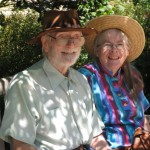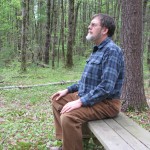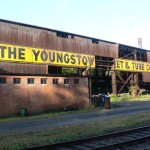The black month November says M de la Villemarque is the month of the dead. On All Saints Eve, (the Scotch Halloween) crowds flock to the grave yards to pray by the family graves, to fill with holy water the little hollows left for this pious purpose in the Breton grave stones, or in some places to offer libations of milk. All night masses for the dead are said and the bells toll; in some places after vespers, the parish priest goes round in procession by torch light to bless the tombs. In every house the cloth and the remains of the supper are left on the table that the souls of the dead may take their seats about the board; the fire too is left burning on the hearth, that the dead may warm their thin hands at the embers as they did in life. When the dead mass has been said, the death bell tolled, the supper eaten, and the household are abed, weird wailings are heard outside the door, blent with the sighing of the wind. They are the songs of the souls, who borrow the voice of the parish poor to ask the prayers of the living.
Halloween is only the beginning.
From then until Yule, the days get shorter, the nights colder, longer, and wilder. However, rarely is there snow to lighten the daylight that does remain. And though the winter days will be even shorter in December, and colder by far by winter’s end, never will they be blacker than in November.
Samhain, it seems to me, is not a single day. Samhain is a tide, a season, an acknowledgment of the rising dark. The custom of honoring the dead, the ancestors, not only on Halloween itself but throughout this season. Ever since I learned of the old Breton custom of naming the month of November “the Black Month,” and reserving it for honoring the dead and for telling tales of ghosts and the supernatural, it has made sense to me. November is a dark and fading time, and I feel it every year.
I live in the United States, where we practice Daylight Savings Time in most (though not all) of our time zones. In the summer, to take advantage of the early morning sunrise, we set our clocks forward, effectively schooling ourselves to rise earlier. In the fall, in recognition of the later dawns, we set our clocks back, sleeping in later to match the sun. And though the purpose is supposed to be energy savings, it has seemed both dire and appropriate that for the last few years, the change from Daylight Savings to Standard Time has come after Halloween, during the Black Month.
It has been harder and harder to rise in the morning of late. Of course, I am a school teacher, and my day begins earlier than most people’s; it is never precisely easy to be up and out of bed at 5:30 AM. But these last few weeks, as the sun has begun to slip farther and farther south on the horizon, and to peek lazily over the horizon later and later in the day, it has become challenging indeed. I’m out the door and on my way to work by 6:30 AM, and each morning now, I face the challenge of either trying to fit my house-key into the lock in complete darkness, or to leave the porch lights on throughout the day, like a sign advertising that no one is at home.
 |
| Photo: Google, 2012 |
Each day, on my morning’s drive, I navigate winding roads beside rivers, streams, and farm fields, normally scenic and lovely, but in November, utterly dark but for my headlights and a few windows along the way, home to early risers like me. I have driven this route for three years now, and it has become familiar enough to me that I know its moods and its seasons; in June, I know the stretch of cultivated red pines that will smell like heaven in the early summer heat; in October, I know the stretch of woods that will become incandescent with changing autumn leaves. And at all seasons, I know that one of the loveliest spots on my commute is in the center of the village of Westhampton, dashing past a series of 18th Century frame houses, gardens, and a big white Congregational church. No more quintessential New England view exists in my day and age, and it always takes my breath away…
When I can see it, that is.
Come Yule, I know, just at that spot I will see the horizon blushing faintly rose with dawn exactly when I break into the open in Westhampton. Come Yule, I will begin to watch the creeping light returning to blaze out just a little more frankly, a little more fully, every morning on my ride.
It hardly seems right, but here it is November, and there is no light in Westhampton Center when I reach it–only the faintest, most timid smudge of pink in the ashes to the east.
It brings me down for the whole day, not seeing that light; it will be one thing, in December, when the waning light promises its near return, and when snow begins to pick up and echo back to the sky the first light of day. But now, in the Black Month, still so far from Yule? The darkness seems cruel and inexorable.
Partly this is the changing weather patterns of climate change. When I was a girl, October was the clearest month, with clear skies every night and crisp fall days near guaranteed each day. Now, however, with more and more severe tropical storms, and a hurricane season that seems infinitely extended, October has become wet… and dark. Already, I have been without the sun for a very long time.
Changing the clocks this weekend will help–for a while. But by the time Yule itself rolls around, I will have been living in the dark long enough that I will feel the effects in my body. I will feel sluggish. It will be hard to wake in the mornings, or to stay awake at night. I may begin to feel sad, mournful.
I could call it by modern jargon, label it “Seasonal Affective Disorder,” and choose to light-bomb it out of existence. Full spectrum light panels are all the rage where I live. But I choose not to do this.
 |
| Wild Jagd, FW Heine. 1882 |
Instead, I’ll set up small lights, pretty twinkling lights on strings, and I’ll put them in my house. I’ll burn more candles; I’ll make my hearth light with strings of lights as well, since my fireplace has a flue that does not function. And I’ll welcome the gray, the black, the dark, leaving offerings for our ancestors both at our Samhain table and throughout the month. I will remember my friends and my family who have died, burning candles and putting out water, meat, and wine to thank them and to thank the spirits of this land where I now live.
I’m going to go inward, and allow myself to belong to the dark of roots and waiting for a while. I’ll read sad stories, sing sad songs, and make myself ready to celebrate our American Thanksgiving–a tradition dearly loved by many of my personal ancestors–at the end of this dark month. Only then will I bring in the evergreens, put up the stars and suns and leaping deer icons we decorate the house with for Yule.
Samhain is not a day; Samhain is a tide.
I will swim in this tide for a month, until it releases me for the return of the sun.















